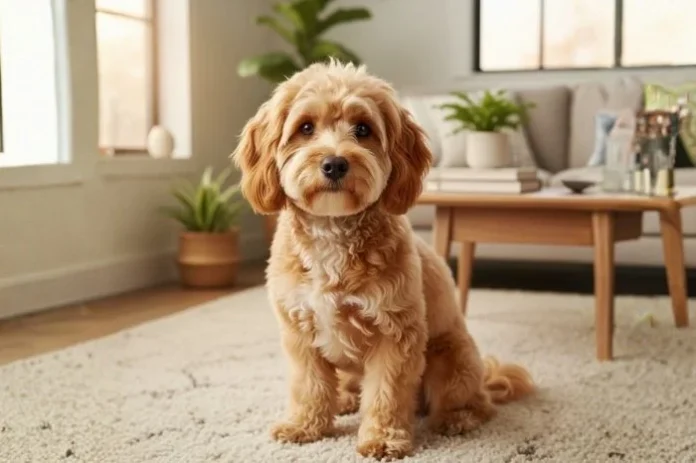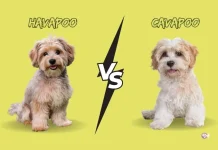If you have ever met a Havapoo (also known as the Havanoodle, Havadoole, or Poovanese), you know why everyone falls head over heels in love with them the very first moment. Just picture a snuggly, curly bundle of joy who’s like a living teddy bear and welcomes you with shining eyes. That’s the Havapoo.
This breed is a mix of a Poodle (typically Toy or Miniature) and a Havanese. The Havanese contributes charm, love, and that eternally happy energy, and the Poodle contributes brains and a hypoallergenic coat. Taking these and blending them together, they produce one of the most adorable poodle crosses around.
The Havapoo started appearing in the U.S. some decades ago when designer dogs gained popularity. The breeders were looking for a small, family-friendly pet that did not shed much, and the Havapoo was just the one.
Also, my buddy adopted a Havapoo puppy named Milo. She still reports that he’s the best of both worlds when it comes to lapdog snuggles and playful pandemonium. He’ll shred the living room to pieces and then snuggle like a baby afterwards. That’s Havapoo personality in a nutshell. This article will cover everything about Havapoos.
Havapoo Size, Weight, and Growth Stages
One of the first things that people ask is: How large does a Havapoo get? Because the parents are small breeds, Havapoos are small, but they grow in phases.
Havapoo Growth Chart
| Age | Weight Range | Height Range | Notes on Development |
|---|---|---|---|
| 4-8 weeks | 1-3 pounds | 3-5 inches | Nursing, weaning onto soft foods, first vaccinations, and early bonding |
| 2-3 months | 3-6 pounds | 5-7 inches | Rapid growth; teething begins |
| 4-6 months | 6-10 pounds | 7-9 inches | Puppy energy peak; socialization critical |
| 7-9 months | 8-13 pounds | 9-10 inches | Muscle development and growth slow |
| 10-12 months | 9-15 pounds | 9-11 inches | Nearly full-grown; coat matures |
| Adults | 10-20 pounds | 9-15 inches | Fully grown; size depends on Toy vs Mini Poodle parent |
Most Havapoos stay 10–20 pounds full-grown, with a height of 9–15 inches. They’re small enough for apartment living but sturdy enough to keep up on walks and playdates. Cavapoos often fall in a similar size range, but may have slightly different coat textures and energy levels.
Colors and Coat Personality
Havapoos come dressed in all kinds of outfits. You might see them in cream, white, apricot, black, chocolate, or gray, sometimes with two or three colors blended. Their coats range from soft waves to tighter Poodle curls.
And yes, people often ask: Are Havanese hypoallergenic? The Havanese itself is a low-shedding dog, and since the Poodle is too, the Havapoo usually ends up being allergy-friendly. Just keep in mind, no dog is 100% hypoallergenic.
I met a Havapoo named Daisy once who had the most gorgeous caramel coat. Her owner swore people stopped them on walks just to ask if she was a stuffed toy.
Temperature & Living Needs
Havapoos are house dogs at heart. They do receive some protection from their coats, but are not weather-hardy for hot or cold. For warm temperatures, keep them cool at home with A/C and water breaks. For chilly temperatures, a lovely warm sweater is magic.
They’re great apartment dogs if they receive their daily walks, some fetch play, and plenty of attention from the family. Outfitting your home with dog essentials makes it easier to keep them happy and safe indoors. Havapoos aren’t solitary animals, really; they love being a part of your daily routine.
Adopting one? Definitely possible. While many are sold by breeders, you can also check rescues that specialize in poodle mixes. Bringing home a Havapoo puppy is thrilling, but it can also come with unexpected emotional ups and downs. Many new owners experience “Puppy Blues,” which is a feeling of stress, overwhelm, or sadness in the first weeks after adoption, so knowing how to cope matters.
Havapoo Health Issues
As with all breeds, Havapoos are prone to some health issues, some from the Havanese, some from the Poodle breed. Understanding them helps you take care of them better.
Progressive Retinal Atrophy (PRA)
- Inherited eye disease that leads to blindness.
- Prevention: Choose a breeder who screens for PRA and has yearly eye exams.
Periodontal Disease
- Small dog breeds are susceptible to gum disease due to tooth crowding.
- Prevention: Brush daily, use dental chews, and have cleanings at the vet.
Legg-Calve-Perthes Disease
- An illness in which the hip joint wears away because of inadequate blood supply.
- Prevention: Keep your puppy at a healthy weight; early treatment at the vet will prevent it.
Patellar Luxation
- A “slipping kneecap” that causes dogs to limp or hop in their step.
- Prevention: Prevent them from jumping around when they’re developing, monitor weight, and consider surgery if it’s bad.
Story time: Milo (the Havapoo I mentioned earlier) once had a mild case of patellar luxation. His vet recommended keeping him lean and avoiding stairs during puppyhood. He’s fine now, but it shows why regular checkups matter.
Feeding Your Havapoo
Food is love for a Havapoo, but it needs to be the right kind.
- Calories: 300–500 per day (depending on activity).
- Protein: Lean meats like chicken, turkey, salmon, or beef. All these should be boneless.
- Carbs: Brown rice, sweet potato, oats.
- Healthy fats: Omega-3s from fish oil or flaxseed for coat shine.
- Schedule: 2–3 meals daily; small breeds are prone to low blood sugar if they skip meals.
Real-time story: Daisy’s owner told me she gives her a mix of high-quality small-breed kibble with a spoonful of salmon oil. Daisy’s coat? Glossy enough to be on a shampoo commercial.
Final Thoughts
The grown-up Havapoo is small, snuggly, and completely adorable. No matter what you call them, a Havanese Poodle mix or a Poovanese, they bring houses full of infinite joy.
From their teddy-bear appearance to their faithful dispositions, they’re the greatest reminder that sometimes the best things really do come in small, curly-haired packages. Both Havapoos and Cavapoos are known for their affectionate nature. However, their energy levels and social tendencies can differ.
But trust me, once you meet a Havapoo, you’ll see why so many families can’t possibly imagine living without one.
FAQs About Havapoos
Yes, Havanese are hypoallergenic because they shed so little. Havapoos tend to inherit this.
The Havanese will live 14–16 years, and Havapoos tend to have a similar lifespan if healthy.
Depending on breeder and location, plan to spend $800–$2,500. Rescues can be cheaper.
They’re gentle, playful, and social, ideal for families.
Yes. Brushing your teeth every day (3–4 times a week), routine professional trimming every 6–8 weeks, and cleaning your ears are required.
Yes! Havapoos are right up there with Cavapoos, Goldendoodles, and Labradoodles.





